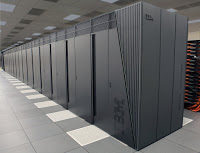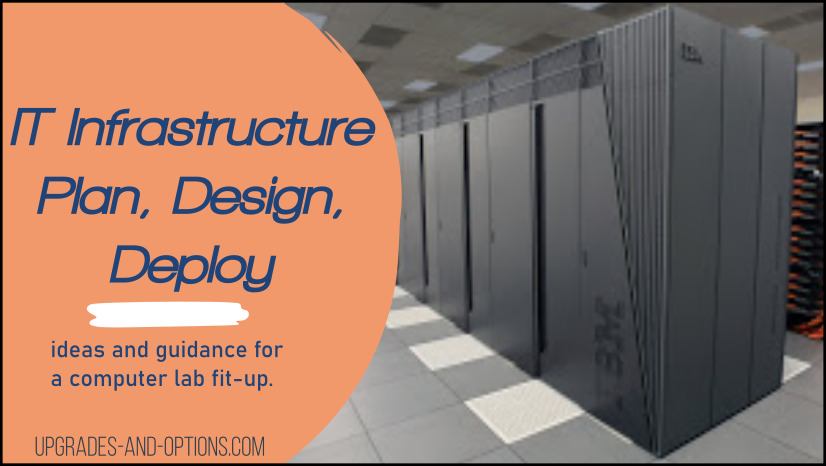IT Infrastructure Plan, Design, Deploy
A well-thought IT Infrastructure plan and components are critical for any business. It lays out the foundation for all future IT endeavors, from server setups and deployments to network expansions.
Every step of the process is critical, from analyzing your needs to designing the perfect solution to deploying the hardware. Without a comprehensive IT plan in place, chances are things will not go as smoothly as hoped and you may not be able to achieve the desired results.
In this article, we will outline each step of the IT Infrastructure Plan and Deployment Process so that you can create a road map for success.
The IT Infrastructure Plan, Design, Deploy chapter provides ideas and guidance for a computer lab fit-up.
Whether you are starting up and outfitting a new lab or reworking an existing lab to make it more productive and efficient, having a complete road map in place will ensure things go smoothly.
Developing a comprehensive IT Infrastructure plan is a vital component to ensure success.
Where to start?
How do you know what needs to be done, what to look for, and how to put it all together?
This chapter explains just that. From initial analysis to planning and designing, and finally, deploying the hardware servers, racks, and networking.
IT Infrastructure Plan and Components

An IT plan should start with analyzing the business need. Is your organization looking to start up a new lab or re-fitting an existing lab space?
What’s The IT Infrastructure Core Vision?
Create a concept detailing the needs and requirements from the team members. Then proceed to quantify how these requirements can be met.
In reality, financial constraints may place limits on the original concept. Look at alternative solutions and revise the plan; you may have to forego purchasing all the servers you initially wanted, for example.
A plan should start with analyzing the business need. Create a concept detailing needs and requirements.
Space Planning
Take into consideration space planning.
Map out the size of your lab, where will the equipment be placed? Adhere to the concept of hot/cold aisles by placing server racks next to each other so all heat is vented on the same side.
This allows for the cold air intake to be on the cold aisles fed by the a/c.
Related Article: Data Center and Server Farm Differences (helpful guide)
Electrical Planning
Electrical planning cannot be overlooked. Find out what is being fed into the lab currently in terms of 110v and 220v(208v) outlets.
Look at the data specifications of the hardware you will be buying and compute their power draw. If you need to add electrical power find out who the facility’s contact is.
You’ll probably use power distribution units(PDUs) for the server hardware, which may come with the racks.
Calculate your electrical requirements and PDU needs.
Network Planning
Purchase robust network routers and switches with 24/7 support. Where will the network equipment be placed, in server racks feeding back to the central router?
Do you need network cable runs or whips to feed out to the server racks? Will you need to coordinate connecting your network to the site’s core routers?
If so, find the site network contact and start the process as soon as possible. You don’t need any delays later on when you can get the ball rolling early.
Determine router, switch, and network cable needs.
To dive deeper into the hands-on nuts and bolts of moving into and setting up your new lab space, read my article: What is IT infrastructure design? (info guide).
IT Infrastructure Design
So far we’ve covered planning and just touched on design. It’s time to create a technical layout design of the lab space showing the equipment.
Create Technical Layout
Include electrical power runs, network cabling, and placement of cooling floor tiles to help visualize the project.
You might think about drafting your lab’s processes and policies at this point. Create a policy to cover security, users, backups, change management, and problem management.
Change Management Policy
A change management policy should strive for minimal disruption of service. It should have an approval process in place and should send notifications to affected users and management.
Change management is important because it is part of risk management. It allows you to manage change on your schedule in a documented, repeatable process.
IT Infrastructure Deployment
Deployment should provide a framework for the successful management of the computer lab. The deployment aspect of an IT Infrastructure plan must meet certain requirements.
A detailed plan allows for structure and a repeatable manner in order to reduce the risk of failure. Well-defined processes allow you to monitor the status/health of the computer lab and thus take action when required to repair or correct faults that do occur.
Test New Deployment
Of course, it is important to plan and test any new deployment previous to inserting it into the current online server environment.
Summary
We’ve introduced the important processes of IT Infrastructure Plan, Design, Deploy that anyone involved in an infrastructure environment should consider. Become familiar with the needs and requirements of your specific environment and adapt these principles to best support you and your team. If you made it this far, also read my article on web hosting titled: Web Hosting Basics Explained | READ


